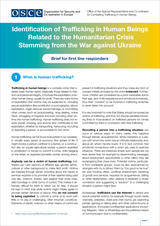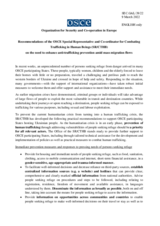
Crisis-related vulnerabilities

Disasters and crises increase the risk of human trafficking. Crises weaken protection systems, making victims more vulnerable.
Quick links
Strengthening anti-trafficking measures amid emergencies
When disaster strikes, traffickers see opportunities. Crisis situations—whether caused by armed conflicts, natural disasters, economic instability or health emergencies—significantly increase the risk of human trafficking. People on the move, including those fleeing war zones or navigating complex migration routes, often face exploitation, abduction and abuse, both during their journeys and upon arrival in destination countries. Health emergencies or natural disasters can further weaken protection systems, leaving vulnerable groups exposed.
The OSCE adopts a comprehensive approach, equipping first-line responders and policymakers with tools and guidance to identify and support victims, share best practices and strengthen cross-border co-operation. By addressing these evolving risks, the Organization helps its participating States protect at-risk populations and prevent trafficking in times of crisis.
News and activities
Current announcements, press releases, media advisories and other updates
Projects
Initiatives funded by individual states and organizations
Resources
Official OSCE documents, publications and other manually selected resources

Identification of trafficking in human beings related to the humanitarian crisis stemming from the war against Ukraine - Brief for first line responders

Addressing trafficking in human beings related to the humanitarian crisis stemming from the war against Ukraine - Code of conduct for first line responders

Recommendations of the OSCE Special Representative and Co-ordinator for Combating Trafficking in Human Beings on the need to enhance anti-trafficking prevention amid mass migration flows


